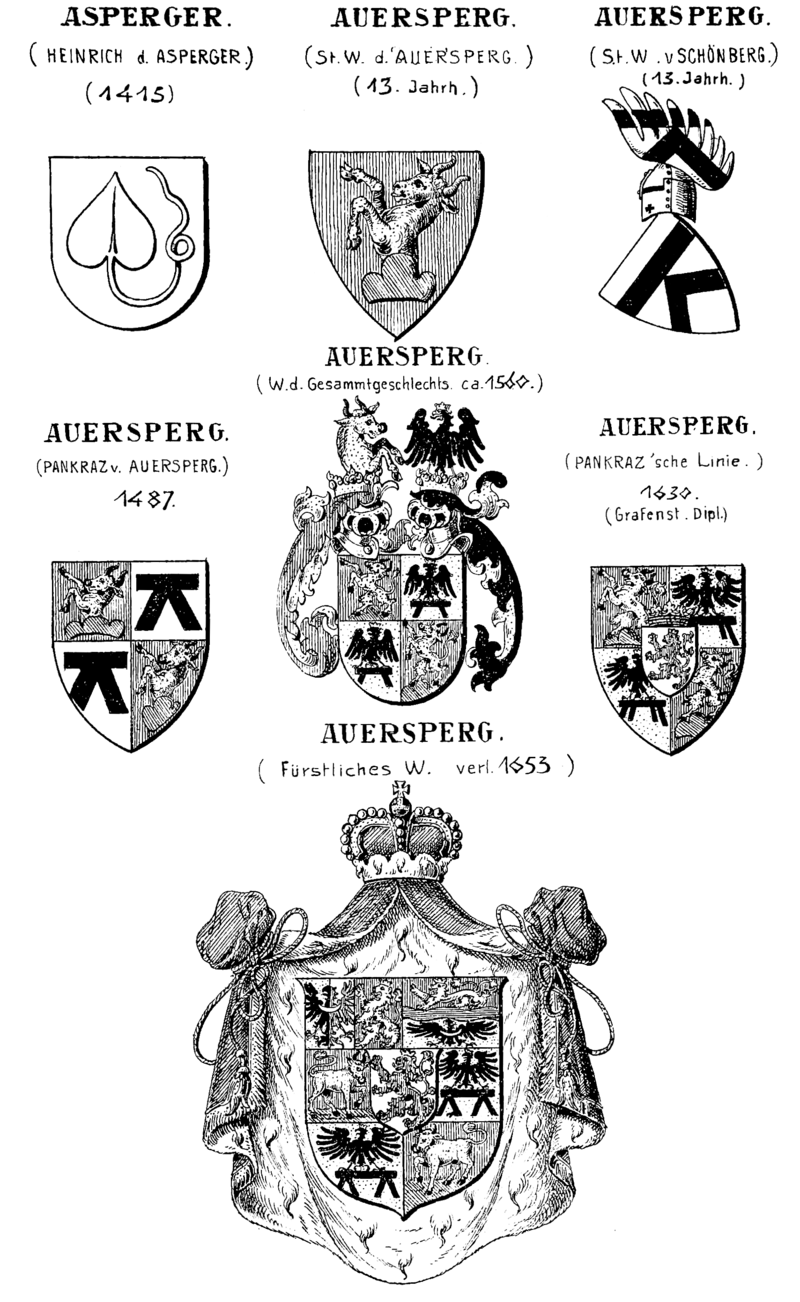
The House of Auersperg (Slovene: Auerspergi or Turjaški) is an Austrian princely family, which held estates in Austria and Tengen (in Baden-Württemberg, Germany). The princely family of Auersperg was a junior branch of the house of Counts of Auersperg from Carniola, one of the hereditary Habsburg duchies and what is now in Slovenia. It rose to princely status in 1653 and after acquiring Tengen, they became immediate Princes of the Holy Roman Empire. The princes of Auersperg also held at various times the duchies of Münsterberg and Gottschee. Their territories were mediatised by Austria and Baden in 1806. The family is counted as high nobility.
The former edelfrei family was first mentioned as Ursperch in an 1162 deed issued by Duke Herman II of Carinthia at his residence St. Veit. Their ancestral seat was Turjak Castle (German: Burg Ursperg, later Burg Auersperg) in the March of Carniola, according to an engraving on site built in 1067 by one Conrad of Auersperg. Above the engraving stands the original Auersperg coat of arms, displaying an aurochs (German: Auerochs(e) or Ur, Slovene: Tur). The family name may derive from Ursberg in Swabia, their ancestors probably settled in Lower Carniola after the victory of King Otto I of Germany over the Hungarian forces at the 955 Battle of Lechfeld. They held large estates from Grosuplje in the north down to Velike Lašče and Ribnica, rivalling with the Meinhardiner counts of Görz, the Carinthian Ortenburg dynasty and the Patriarchs of Aquileia.
In the 13th century, the high noble line became extinct and was succeeded by a dynasty of ministeriales. In the mid 15th century, this line split into two eponymous branches with the brothers Pankraz II (1441-1496) and Volkhard VIII (1442-1508). The Auerspergs inherited the estate of Žužemberk and Šumberk in the Windic March, which passed on to a cadet branch. Pankraz II of Auersperg held Turjak Castle in the Duchy of Carniola, married with Anne of Frankopan. His son Trojan (1495–1541) served at the Habsburg courts in Ljubljana and the Austrian capital Vienna as a Carniolan chamberlain and regent, Imperial Hofrat and commander during the Ottoman Siege of Vienna in 1529. Trojan’s son Herbard VIII von Auersperg (1528–1575), called Hervard Turjaški in Slovene, was Carniolan Landeshauptmann and commander of the Croatian and Slavonian Military Frontier, he played a vital role as a patron of Primož Trubar, Jurij Dalmatin and the Protestant Reformation in the Slovene Lands. He received the noble rank of an Imperial Baron (Reichsfreiherren) in 1550, his descendants were elevated to Imperial Counts (Reichsgrafen) in 1630.

The Auersperg cadet branch, named after the castle of Šumberk in Lower Carniola, was influential throughout the 16th century. Wilhelm Auersperg (called “the Rich”, cca. 1462-1507) and his nephew Hans (1480-1529) were regents (Landeshauptmann) of Carniola. Hans’s son Wolfgang-Engelbert was considered one of the most educated noblemen in Carniola, and a strong supporter of Lutheranism. His son Andreas von Auersperg was one of the military commanders during the decisive Battle of Sisak against the Ottomans, gaining the nickname “Carniolan Achilles”. In the early 17th century, the Šumberk cadet line, which was considered wealthier and more influential than the main one, died out; its estates were transferred back to the main line, and were later mostly inherited by the so-called “princely branch” of the family.